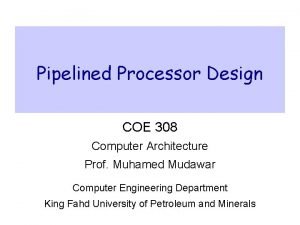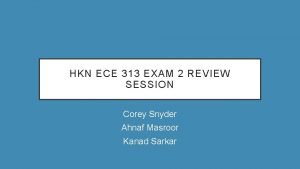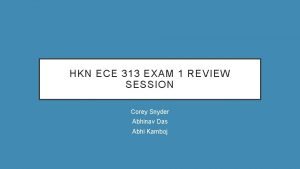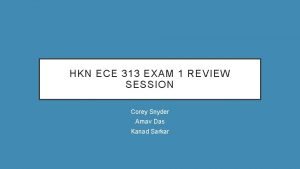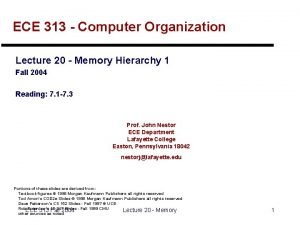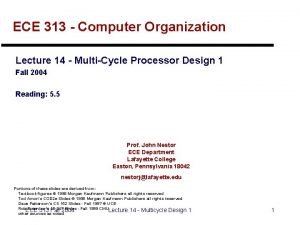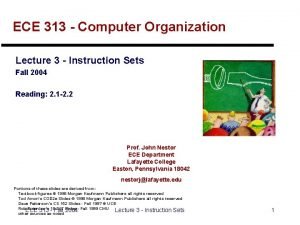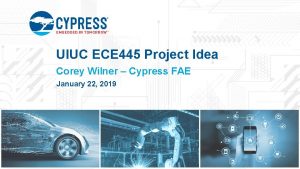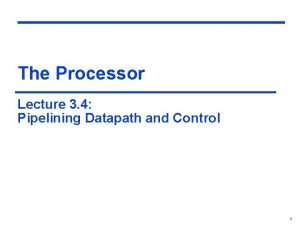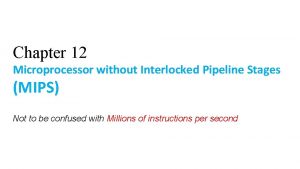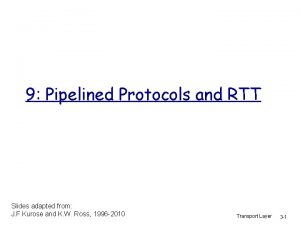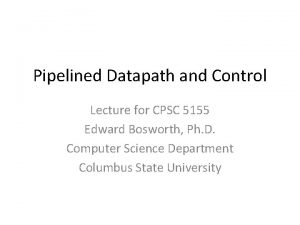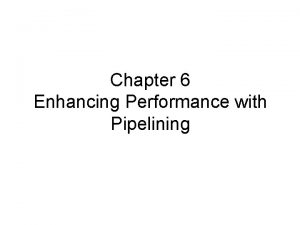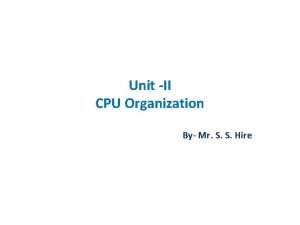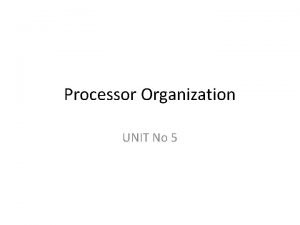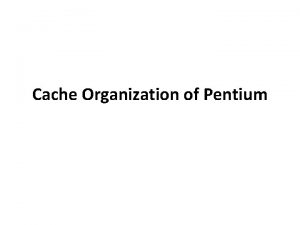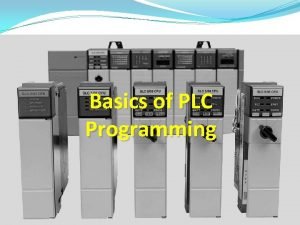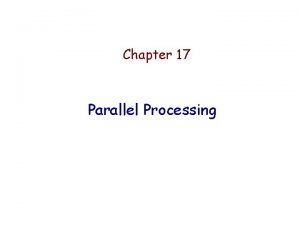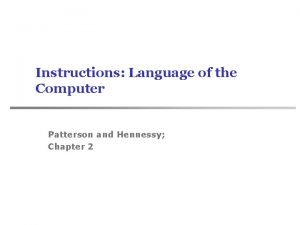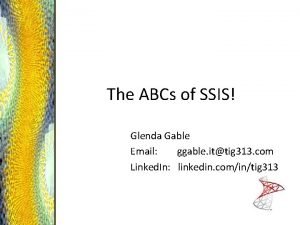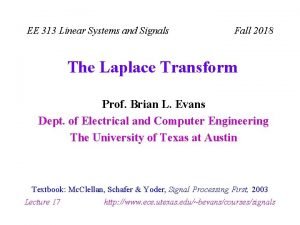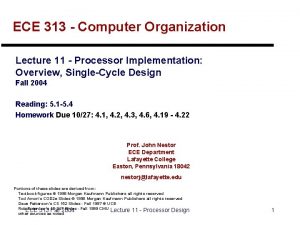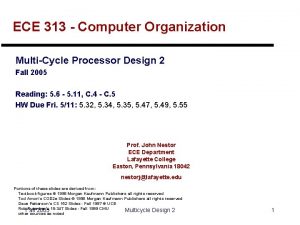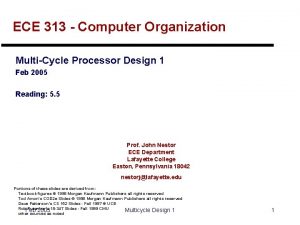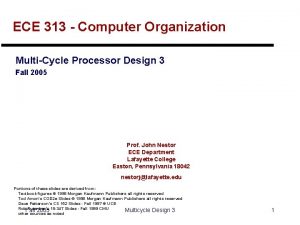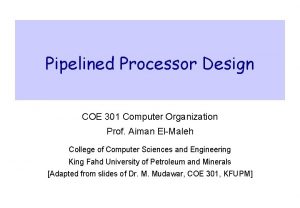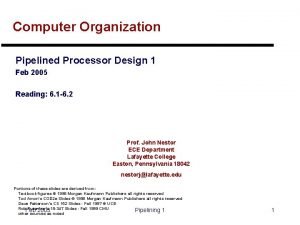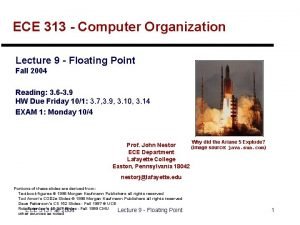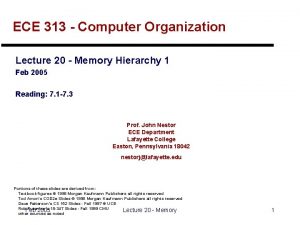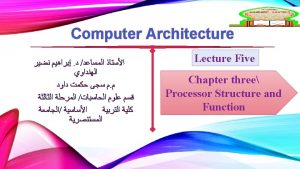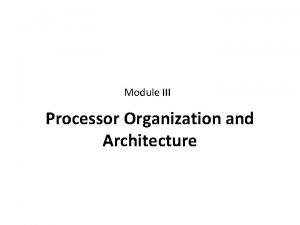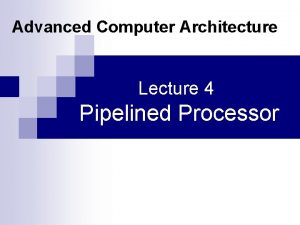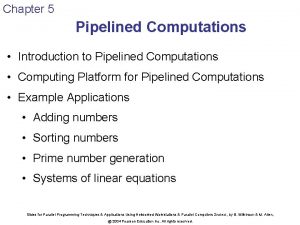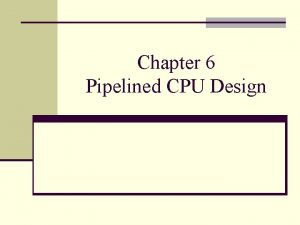ECE 313 Computer Organization Lecture 17 Pipelined Processor






























- Slides: 30

ECE 313 - Computer Organization Lecture 17 - Pipelined Processor Design 1 Fall 2004 Reading: 6. 1 -6. 2 Prof. John Nestor ECE Department Lafayette College Easton, Pennsylvania 18042 nestorj@lafayette. edu Portions of these slides are derived from: Textbook figures © 1998 Morgan Kaufmann Publishers all rights reserved Tod Amon's COD 2 e Slides © 1998 Morgan Kaufmann Publishers all rights reserved Dave Patterson’s CS 152 Slides - Fall 1997 © UCB Rob Rutenbar’s 18 -347 Slides - Fall 1999 CMU ECE 313 Fall 2004 Lecture 17 - Pipelining 1 other sources as noted 1

Basic Pipelined Processor Pipeline Registers IF/ID ECE 313 Fall 2004 ID/EX Lecture 17 - Pipelining 1 EX/MEM MEM/WB 15

Single-Cycle vs. Pipelined Execution Non-Pipelined ECE 313 Fall 2004 Lecture 17 - Pipelining 1 16

Comments about Pipelining } The good news } Multiple instructions are being processed at same time } This works because stages are isolated by registers } Best case speedup of N } The bad news } Instructions interfere with each other - hazards • Example: different instructions may need the same piece of hardware (e. g. , memory) in same clock cycle • Example: instruction may require a result produced by an earlier instruction that is not yet complete } Worst case: must suspend execution - stall ECE 313 Fall 2004 Lecture 17 - Pipelining 1 17

Pipelined Example Executing Multiple Instructions } Consider the following instruction sequence: lw $r 0, 10($r 1) sw $r 3, 20($r 4) add $r 5, $r 6, $r 7 sub $r 8, $r 9, $r 10 ECE 313 Fall 2004 Lecture 17 - Pipelining 1 18

Executing Multiple Instructions Clock Cycle 1 LW ECE 313 Fall 2004 Lecture 17 - Pipelining 1 19

Executing Multiple Instructions Clock Cycle 2 SW ECE 313 Fall 2004 LW Lecture 17 - Pipelining 1 20

Executing Multiple Instructions Clock Cycle 3 ADD ECE 313 Fall 2004 SW LW Lecture 17 - Pipelining 1 21

Executing Multiple Instructions Clock Cycle 4 SUB ECE 313 Fall 2004 ADD SW Lecture 17 - Pipelining 1 LW 22

Executing Multiple Instructions Clock Cycle 5 SUB ECE 313 Fall 2004 ADD Lecture 17 - Pipelining 1 SW LW 23

Executing Multiple Instructions Clock Cycle 6 SUB ECE 313 Fall 2004 Lecture 17 - Pipelining 1 ADD SW 24

Executing Multiple Instructions Clock Cycle 7 ADD SUB ECE 313 Fall 2004 Lecture 17 - Pipelining 1 25

Executing Multiple Instructions Clock Cycle 8 SUB ECE 313 Fall 2004 Lecture 17 - Pipelining 1 26

Alternative View - Multicycle Diagram ECE 313 Fall 2004 Lecture 17 - Pipelining 1 27

Pipeline Hazards } Where one instruction cannot immediately follow another } Types of hazards } Structural hazards - attempt to use same resource twice } Control hazards - attempt to make decision before condition is evaluated } Data hazards - attempt to use data before it is ready } Can always resolve hazards by waiting ECE 313 Fall 2004 Lecture 17 - Pipelining 1 29

Structural Hazards } Attempt to use same resource twice at same time } Example: Single Memory for instructions, data } Accessed by IF stage } Accessed at same time by MEM stage } Solutions } Delay second access by one clock cycle, OR } Provide separate memories for instructions, data • This is what the book does • This is called a “Harvard Architecture” • Real pipelined processors have separate caches ECE 313 Fall 2004 Lecture 17 - Pipelining 1 30

Example Structural Hazard Single Memory Conflict ECE 313 Fall 2004 Lecture 17 - Pipelining 1 31

Control Hazards } Attempt to make a decision before condition is evaluated } Example: beq $s 0, $s 1, offset } Assume we add hardware to second stage to: } Compare fetched registers for equality } Compute branch target } This allows branch to be taken at end of second clock cycle } But, this still means result is not ready when we want to load the next instruction! ECE 313 Fall 2004 Lecture 17 - Pipelining 1 32

Control Hazard Solutions } Stall - stop loading instructions until result is available } Predict - assume an outcome and continue fetching (undo if prediction is wrong) } Delayed branch - specify in architecture that following instruction is always executed ECE 313 Fall 2004 Lecture 17 - Pipelining 1 33

Control Hazard - Stall ECE 313 Fall 2004 beq writes PC here new PC used here Lecture 17 - Pipelining 1 34

Control Hazard - Correct Prediction Fetch assuming branch taken ECE 313 Fall 2004 Lecture 17 - Pipelining 1 35

Control Hazard - Incorrect Prediction “Squashed” instruction ECE 313 Fall 2004 Lecture 17 - Pipelining 1 36

Control Hazard - Delayed Branch always executes correct PC avail. here ECE 313 Fall 2004 Lecture 17 - Pipelining 1 37

Summary - Control Hazard Solutions } Stall - stop fetching instr. until result is available } Significant performance penalty } Hardware required to stall } Predict - assume an outcome and continue fetching (undo if prediction is wrong) } Performance penalty only when guess wrong } Hardware required to "squash" instructions } Delayed branch - specify in architecture that following instruction is always executed } Compiler re-orders instructions into delay slot } Insert "NOP" (no-op) operations when can't use (~50%) } This is how original MIPS worked ECE 313 Fall 2004 Lecture 17 - Pipelining 1 38

Data Hazards } Attempt to use data before it is ready } Solutions } Stalling - wait until result is available } Forwarding- make data available inside datapath } Reordering instructions - use compiler to avoid hazards } Examples: add $s 0, $t 1 ; $s 0 = $t 0+$t 1 sub $t 2, $s 0, $t 3 ; $t 2 = $s 0 -$t 3 lw $s 0, 0($t 0) ; $s 0 = MEM[$t 0] sub $t 2, $s 0, $t 3 ; $t 2 = $s 0 -$t 3 ECE 313 Fall 2004 Lecture 17 - Pipelining 1 39

Data Hazard - Stalling ECE 313 Fall 2004 Lecture 17 - Pipelining 1 40

Data Hazards - Forwarding } Key idea: connect new value directly to next stage } Still read s 0, but ignore in favor of new result } Problem: what about load instructions? ECE 313 Fall 2004 Lecture 17 - Pipelining 1 41

Data Hazards – Forwarding the load result } STALL still required for load - data avail. after MEM } MIPS architecture calls this delayed load, initial implementations required compiler to deal with this ECE 313 Fall 2004 Lecture 17 - Pipelining 1 42

Data Hazards - Reordering Instructions } Assuming we have data forwarding, what are the hazards in this code? lw lw sw sw $t 0, $t 2, $t 0, 0($t 1) 4($t 1) } Reorder instructions to remove hazard: lw lw sw sw $t 0, $t 2, ECE 313 Fall 2004 0($t 1) 4($t 1) 0($t 1) Lecture 17 - Pipelining 1 43

Summary - Pipelining Overview } Pipelining increase throughput (but not latency) } Hazards limit performance } Structural hazards } Control hazards } Data hazards ECE 313 Fall 2004 Lecture 17 - Pipelining 1 44
 Pipelined processor design
Pipelined processor design Corey snyder uiuc
Corey snyder uiuc Ece 313
Ece 313 Ece 313 uiuc
Ece 313 uiuc Ece 313
Ece 313 Ece 313
Ece 313 Ece 313
Ece 313 Uiuc ece 445
Uiuc ece 445 Ece 313
Ece 313 Pipelined datapath and control in computer architecture
Pipelined datapath and control in computer architecture Organisasi komputer
Organisasi komputer Process organization in computer organization
Process organization in computer organization Microprocessor without interlocked pipelined stages
Microprocessor without interlocked pipelined stages Pipelined protocol
Pipelined protocol Pipelined datapath
Pipelined datapath Pipelined datapath
Pipelined datapath 01:640:244 lecture notes - lecture 15: plat, idah, farad
01:640:244 lecture notes - lecture 15: plat, idah, farad Processor organization
Processor organization Data flow, fetch cycle
Data flow, fetch cycle In pentium code cache is of
In pentium code cache is of Processor memory organization in plc
Processor memory organization in plc Processor organization
Processor organization Patterson hennessy
Patterson hennessy Basic structure of a computer
Basic structure of a computer Computer organization and computer architecture difference
Computer organization and computer architecture difference Basic computer organization and design
Basic computer organization and design Design of basic computer in computer architecture
Design of basic computer in computer architecture Terminator learning computer
Terminator learning computer 100/313
100/313 Ssis-313
Ssis-313 Ee 313
Ee 313
